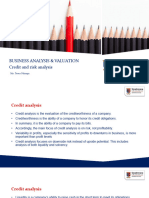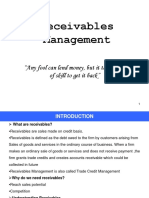0 ratings0% found this document useful (0 votes)
86 viewsCredit Rating: Dr. Kanhaiya Singh
Credit Rating: Dr. Kanhaiya Singh
Uploaded by
Vidisha SinghalCredit ratings provide grades that summarize an entity's ability and willingness to repay debts. Major rating companies like S&P, Moody's, and Fitch assign letter grades and sub-categories. Ratings are based on an analysis of factors like industry risk, market position, earnings, cash flows, management, capital structure, and corporate governance. The rating process involves meetings, site visits, and rating committee review to establish initial ratings and ongoing surveillance.
Copyright:
Attribution Non-Commercial (BY-NC)
Available Formats
Download as PPT, PDF, TXT or read online from Scribd
Credit Rating: Dr. Kanhaiya Singh
Credit Rating: Dr. Kanhaiya Singh
Uploaded by
Vidisha Singhal0 ratings0% found this document useful (0 votes)
86 views30 pagesCredit ratings provide grades that summarize an entity's ability and willingness to repay debts. Major rating companies like S&P, Moody's, and Fitch assign letter grades and sub-categories. Ratings are based on an analysis of factors like industry risk, market position, earnings, cash flows, management, capital structure, and corporate governance. The rating process involves meetings, site visits, and rating committee review to establish initial ratings and ongoing surveillance.
Original Title
Credit Rating
Copyright
© Attribution Non-Commercial (BY-NC)
Available Formats
PPT, PDF, TXT or read online from Scribd
Share this document
Did you find this document useful?
Is this content inappropriate?
Credit ratings provide grades that summarize an entity's ability and willingness to repay debts. Major rating companies like S&P, Moody's, and Fitch assign letter grades and sub-categories. Ratings are based on an analysis of factors like industry risk, market position, earnings, cash flows, management, capital structure, and corporate governance. The rating process involves meetings, site visits, and rating committee review to establish initial ratings and ongoing surveillance.
Copyright:
Attribution Non-Commercial (BY-NC)
Available Formats
Download as PPT, PDF, TXT or read online from Scribd
Download as ppt, pdf, or txt
0 ratings0% found this document useful (0 votes)
86 views30 pagesCredit Rating: Dr. Kanhaiya Singh
Credit Rating: Dr. Kanhaiya Singh
Uploaded by
Vidisha SinghalCredit ratings provide grades that summarize an entity's ability and willingness to repay debts. Major rating companies like S&P, Moody's, and Fitch assign letter grades and sub-categories. Ratings are based on an analysis of factors like industry risk, market position, earnings, cash flows, management, capital structure, and corporate governance. The rating process involves meetings, site visits, and rating committee review to establish initial ratings and ongoing surveillance.
Copyright:
Attribution Non-Commercial (BY-NC)
Available Formats
Download as PPT, PDF, TXT or read online from Scribd
Download as ppt, pdf, or txt
You are on page 1of 30
Credit Rating
Dr. Kanhaiya Singh
Credit Rating
Process”
Learning Objective
Pricing the Risk!!!
What is a Rating:
• Grade summarizing the willingness and
ability to repay.
•Ability to pay-quantitative
•Willingness to pay-qualitative
•Letter Grades
•Sub-categories of grades.
Major Credit Rating Companies: S &
P, Moody’s,
Fitch etc.
•Locally: JCR-VIS & PACRA
CRISIL,ICRA,CARE
•Why Credit Rating???
A rating is NOT:
•A judgment or statement regarding any aspect of
public policy.
•A political statement in favor of or against a
particular
person or administration.
•A dictate of which should be done or how a matter
should be handled.
Why bother a rating/rating agency:
• •Increase investor acceptance.
Increase investor acceptance.
•Current economic environment.
Current economic environment.
•Current capital market environment.
Current capital market environment.
•BOTTOM LINE: Lower Interest Cost.
BOTTOM LINE: Lower Interest Cost.
Types of Credit Ratings:
• •Sovereign Ratings: Assess the country
Credit risk
and is used as a point of reference for
country
borrowings from WB, IMF, ADB, IDB etc
•Entity Ratings: Risk ratings of Corporate
entities.
Instrument Ratings:
• Ratings of the Bonds issued by
different corporations and municipalities.
Rating Terminologies – Long Term
Rating Terminologies
• Short Term:
•A1+:
A1+:Obligations supported by the highest capacity for
timely
Obligations supported by the highest capacity for timely
repayment.
repayment.
•A1:
A1: Obligations supported by a strong capacity for timely
repayment.
•A2: Obligations supported by a satisfactory capacity for
timely
repayment, although such capacity may be susceptible to
adverse changes in business, economic, or financial
conditions.
•A3: Obligations supported by an adequate capacity
for timely
repayment. Such capacity is more susceptible to
adverse
changes in business, economic, or financial
conditions than for
obligations in higher categories.
•B: Obligations for which the capacity for timely
repayment is
susceptible to adverse changes in business,
economic, or
financial conditions.
•C: Obligations for which there is
an inadequate capacity to
ensure timely repayment.
•D:Obligations which have a high
risk of default or which are
currently in default.
Sectors where Credit Rating Plays a Vital
Role:
• –Commercial Banks:
–Mutual Funds:
–Investment Banks:
–Leasing Companies:
–Insurance Companies:
–Bonds & Securitization etc
The Rating Process:
• –Step I: Decision and documents
–Step II: Rating Presentations – meetings,
conference
calls, and /or site visits
–Step III: Rating Committee,
communication, press
release, report
–Appeal process, if necessary
–Surveillance
Rating Methodology
• Following major factors are assessed in the Credit
Rating
Process:
•Industry Risk
•Market Position
•Ownership & Support
•Earning & Performance
•Cash Flows
•Management Evaluation
•Capital & Debt Structure
•Funding & Flexibility
•Corporate Governance
•Additional Factors for Financial Institutions
I - Industry Risk
• •Economic importance of the industry to the country.
•Potential for support.
•Employment significance.
•Industrial relations record.
•Significance of legislation: protective and harmful,
relationship with government.
•Maturity of the industry.
•International competition.
•Barriers to entry.
•Competitive situation domestically: monopoly, oligopoly,
fragmentation.
•Nature of the industry: capital intensity, product lifespan,
marketing
requirements.
Cyclic factors:
• demand, supply, implications for price
volatility.
•Industry cost and revenue structure:
susceptibility to energy prices, interest rate
levels, government policies.
•Important developments and trends in the
industry.
Market Position
•Competitive position within the industry: size,
market share & trend, price-setting ability.
•Major product importance.
•Product lives and competition.
•Degree of product diversification.
•Significance of R&D expenditure and of new
product development.
•Geographic diversity of sales and
production.
•Significance of major customers.
•Dependence on major suppliers and
access to alternatives.
•Marketing needs.
•Distribution network, control and
susceptibility to external factors.
•What are the growth trends, and sources of
growth?
Ownership & Support
• The specific issues include:
•Ownership of the entity.
•Relationship with owners, autonomy, control.
•Financial strength of owner (s).
•Potential for support or for funds withdrawals.
•Structure of ownership.
•Other benefits: access to technology, products.
•Access to ca ital markets.
Earnings & Performance
• The specific issues include:
•Consistency and trend of core earnings.
•Earnings mix by activity and geography.
•Exceptional and extraordinary items: non-
recurring impacts on
past earnings levels.
•True earnings levels available for cash flow:
equity accounting,
restrictions on profit repatriation.
•Internal growth versus acquired earnings.
Contd…
•Profitabilityand protection measures.
•Profit margins.
•Interest & pre-tax coverage measures.
•Dividend cover, payment levels and
future policy.
•Taxation situation: effective tax rate,
specific relief.
•Sufficiency of retained earnings to
finance growth internally.
Cash Flows
• Relationship of cash flow to leverage and ability to internally
meet all cash requirements is evaluated. The volatility of cash
flow over time and the impact of seasonality on cash flow is
also assessed.
The specific issues include :
•Adequacy of cash flow to maintain the operating capacity of
the
business: working capital levels, replacement of fixed assets.
•Contribution from cash flow towards expansion: major capital
spending projects, acquisitions.
•Discretionary spending included in cash flow including
advertising, exploration, research & development
expenditure.
contd…
•Volatilityof cash flow over time.
•Relationship between cash flow and total
debt.
•Restrictions on cash flow : limits on
repatriation, potential
taxation effects, access to dividends from
subsidiaries.
•Liquidity levels and fluctuations:
seasonality, sensitivities.
•Working capital management and
measurements
Management Evaluation
• The specific issues include:
•Record to date in financial terms.
•Corporate goals and outlook: aggressive
stance, attitude to risk.
•Experience, background, credibility.
•Depth of management: key individuals,
succession.
•Record compared with peers.
Capital & Debt Structure
• The specific issues include:
•Debt/Equity measures: historic, present and projected.
•Leverage (total liabilities/equity) measures: historic,
present and
projected
•Sensitivity Analysis on projected levels
•Seasonal variations
•Coverage measures on interest & leasing
•Adjustments for off-balance sheet items.
•Appropriateness of capital structure for the business:
over-
reliance on short term funding, sensitivity to interest rate
changes.
Debt Structure
• Type, maturity, currency, service
schedule,
covenants, security, default clause
Funding & Flexibility
• The specific issues include:
•Flexibility of planned financial needs : capital spending,
dividend
levels, acquisitions.
•Ability to raise additional financing under stress.
•Back-up and standby lines of credit : periods and covenants
of
underwriting facilities and committed lines, bank
relationships
generally.
•Ability to attract capital : shareholder make-up, access to
equity
markets.
•Capital commitments.
Cont..
The specific issues include:
•Flexibility of planned financial needs : capital spending, dividend
levels, acquisitions.
•Ability to raise additional financing under stress.
•Back-up and standby lines of credit : periods and covenants of
underwriting facilities and committed lines, bank relationships
generally.
•Ability to attract capital : shareholder make-up, access to equity
markets.
•Capital commitments.
Cont..
VIII – Funding & Flexibility
•Margin of safety in present and planned gearing/leverage levels.
•Asset make-up : nature of assets and potential for reductions or
disposals under stress, scalable units.
•Off-balance sheet assets and liabilities : goodwill or other intangibles written off,
undervalued assets, pension under funding.
Corporate Governance
• •The independence and effectiveness of the board of
directors
•Oversight of related party transactions that may lead to
conflicts of
interest.
•Board oversight of the audit function.
•Executive and director remuneration.
•Complex holding company structures.
•Ownership by private individuals and families.
•Also examine other aspects of corporate governance
whose impact on
bondholders is less clear cut; these include equity
ownership by
executives and directors
Additional Factors for Financial
Institutions
• •Quality of the asset portfolio
•Stability of earning
•Sources and cost of funds
•Asset / liability structure
•Capital adequacy and liquidity
•Market environment and strategy
•Prospects
You might also like
- Credit and Risk AnalysisDocument15 pagesCredit and Risk AnalysiswarrenmachiniNo ratings yet
- AmBank E-Statement Feb 2023Document5 pagesAmBank E-Statement Feb 2023Farid Othman100% (1)
- Unit III Receivables Management - Concept of Credit PolicyDocument16 pagesUnit III Receivables Management - Concept of Credit PolicyYash Raj Tripathi0% (1)
- Ch2 Principles of Credit ManagementDocument18 pagesCh2 Principles of Credit ManagementSandeep Kumar SuranaNo ratings yet
- Bonds Payable: Prepare The Entries To Record The Above TransactionsDocument6 pagesBonds Payable: Prepare The Entries To Record The Above TransactionsJay-L TanNo ratings yet
- Tutorial 3 IFADocument2 pagesTutorial 3 IFAEileen WongNo ratings yet
- Credit Rating ProcessDocument25 pagesCredit Rating ProcessMonaaa100% (11)
- "Credit Rating Process" What Is A RatingDocument9 pages"Credit Rating Process" What Is A RatingSheetal IyerNo ratings yet
- Principles of LendingDocument37 pagesPrinciples of LendingRohit BaralNo ratings yet
- CH 04 - Credit AnalysisDocument30 pagesCH 04 - Credit AnalysisMohamedNo ratings yet
- Risk AnalysisDocument45 pagesRisk AnalysisRakan AdhitamaNo ratings yet
- Unit 3 PresentationDocument139 pagesUnit 3 PresentationwatkeNo ratings yet
- Credit and Collection PA1Document109 pagesCredit and Collection PA1Lorey Joy IdongNo ratings yet
- Lending - Unit 6 - Monitoring and Control of LendingDocument35 pagesLending - Unit 6 - Monitoring and Control of LendingOrlandoFrassManDolsonNo ratings yet
- CreditDocument8 pagesCreditGustavo100% (1)
- Corporate BankingDocument57 pagesCorporate BankingSoumya TiwaryNo ratings yet
- Types of Risks in Banking Sector: DR - SMDocument30 pagesTypes of Risks in Banking Sector: DR - SMPriya DharshiniNo ratings yet
- Chapter 9 Accounts Receivable ManagementDocument27 pagesChapter 9 Accounts Receivable Managementliowzm-wb24No ratings yet
- Credit Rating: Presentation OnDocument14 pagesCredit Rating: Presentation OnPankaj KhatriNo ratings yet
- Chapter 6 - Fundamentals of Credit AnalysisDocument86 pagesChapter 6 - Fundamentals of Credit Analysisybpdwjg5br100% (1)
- Topic 3 - CREDIT MANAGEMENTDocument43 pagesTopic 3 - CREDIT MANAGEMENTeogollaNo ratings yet
- Corporate Banking: by Prof. Santosh KumarDocument58 pagesCorporate Banking: by Prof. Santosh KumarSuraj KumarNo ratings yet
- 05 Bank Management - Snapshot 05Document44 pages05 Bank Management - Snapshot 05Mohammed MustansirNo ratings yet
- Credit AnalysisDocument16 pagesCredit AnalysishacerserttNo ratings yet
- Credit Rating: - Kanika KhuranaDocument40 pagesCredit Rating: - Kanika KhuranaAnunay AroraNo ratings yet
- Main Topic 5 Risk AnalysisDocument26 pagesMain Topic 5 Risk AnalysisIrish Lhyzel GarciaNo ratings yet
- Credit Risk Measurement and ManagementDocument30 pagesCredit Risk Measurement and Managementkhush preetNo ratings yet
- 2.international FinanceDocument81 pages2.international FinanceDhawal RajNo ratings yet
- FM 05 Unit IDocument9 pagesFM 05 Unit IMO. SHAHVANNo ratings yet
- Unit III Receivables Management Concept of Credit PolicyDocument16 pagesUnit III Receivables Management Concept of Credit Policysumuk kattaNo ratings yet
- Credit RatingDocument30 pagesCredit Ratingtejosh84No ratings yet
- Commercial and Industrial LendingDocument64 pagesCommercial and Industrial LendingSanjeela JoshiNo ratings yet
- Account Receivables Management & Credit Policy: Presented byDocument37 pagesAccount Receivables Management & Credit Policy: Presented byKhalid Khan100% (1)
- Procedure for Credit AdministrationDocument7 pagesProcedure for Credit AdministrationwofkavyxorgseNo ratings yet
- Principles of Sound Lending, Credit PolicyDocument54 pagesPrinciples of Sound Lending, Credit Policyrajin_rammsteinNo ratings yet
- Credit-Management ReviewerDocument34 pagesCredit-Management ReviewerJhay Zem OrtizNo ratings yet
- Unit 4 Receivables - ManagementDocument27 pagesUnit 4 Receivables - ManagementrehaarocksNo ratings yet
- Yeshan Krishnaratne: Introduction To Lending & Credit AppraisalDocument73 pagesYeshan Krishnaratne: Introduction To Lending & Credit Appraisalyeshank100% (2)
- Chapter 1Document49 pagesChapter 1Sami JattNo ratings yet
- Lec 4Document24 pagesLec 4pal 8311No ratings yet
- MSME Unit 3.2 NotesDocument7 pagesMSME Unit 3.2 NotesSyed SuhaibNo ratings yet
- Credit RatingDocument22 pagesCredit RatingPankaj GhevariyaNo ratings yet
- Capital: Owner About Their Stake Hence More Safeguard Will Be The Borrowed FundsDocument28 pagesCapital: Owner About Their Stake Hence More Safeguard Will Be The Borrowed FundsMdramjanaliNo ratings yet
- NYIF Williams Credit Risk Analysis III 2018Document75 pagesNYIF Williams Credit Risk Analysis III 2018jojozieNo ratings yet
- Ratio AnalysisDocument8 pagesRatio AnalysisAbdul RehmanNo ratings yet
- Chapter4. BankingDocument38 pagesChapter4. BankingdhitalkhushiNo ratings yet
- IB Investment Banking_lecture 4 M&A_Fall_2024Document15 pagesIB Investment Banking_lecture 4 M&A_Fall_2024Dariga BaiseitNo ratings yet
- Credit Risk ManagementDocument86 pagesCredit Risk ManagementGodsonNo ratings yet
- FM-Sessions 21 - 24 Capital Structure Decisions (Complete Lecture)Document72 pagesFM-Sessions 21 - 24 Capital Structure Decisions (Complete Lecture)Saadat ShaikhNo ratings yet
- 1 Bank LendingDocument56 pages1 Bank Lendingparthasarathi_inNo ratings yet
- Bank Management - Snap Shot: Chapter ObjectivesDocument44 pagesBank Management - Snap Shot: Chapter ObjectivesNoor QamarNo ratings yet
- Credit ManagementDocument29 pagesCredit ManagementDipesh KaushalNo ratings yet
- Qualitatitive AnalysisDocument32 pagesQualitatitive AnalysisAmirahZulaiqhaNo ratings yet
- 1.+FRA Study+Guide v2.0Document5 pages1.+FRA Study+Guide v2.0Jerlin PreethiNo ratings yet
- Corporate Banking: by Prof. Santosh KumarDocument60 pagesCorporate Banking: by Prof. Santosh KumarAditya RajNo ratings yet
- Working Capital ManagementDocument30 pagesWorking Capital ManagementEvangelineNo ratings yet
- 2.1.credit Appraisal Techniques - Dr. K. Bhavana RajDocument12 pages2.1.credit Appraisal Techniques - Dr. K. Bhavana Raj2203037No ratings yet
- Chapter One: The Principles of Lending and Lending BasicsDocument23 pagesChapter One: The Principles of Lending and Lending BasicsSamuel サム VargheseNo ratings yet
- Lending - Unit 6 - Monitoring and Control of LendingDocument33 pagesLending - Unit 6 - Monitoring and Control of LendingKevin Us-LazPreces TimetoshineNo ratings yet
- Chapter 8 The Financing DecisionDocument38 pagesChapter 8 The Financing DecisionAllene MontemayorNo ratings yet
- CF Unit 1Document41 pagesCF Unit 1Saravanan ShanmugamNo ratings yet
- Et ZC414 13Document20 pagesEt ZC414 13rajpd28No ratings yet
- CA Foundation Accounts Q MTP 3 June 2024 Castudynotes ComDocument8 pagesCA Foundation Accounts Q MTP 3 June 2024 Castudynotes Comdebsounak333No ratings yet
- Auditing Problems: RequiredDocument2 pagesAuditing Problems: RequiredvhhhNo ratings yet
- Toa - 006 Interim Financial Reports: DMC College Foundation's In-House Review (Theory of Accounts)Document1 pageToa - 006 Interim Financial Reports: DMC College Foundation's In-House Review (Theory of Accounts)Earl Russell S PaulicanNo ratings yet
- Cashflow (Direct Method)Document7 pagesCashflow (Direct Method)Umair ShahzadNo ratings yet
- Partnership - FormationDocument16 pagesPartnership - Formationnaufal bimo0% (1)
- Equity FundDocument1 pageEquity Fundvibhanshukumar66No ratings yet
- Ken DyDocument15 pagesKen DyZamantha OliverosNo ratings yet
- Ekansh: Concepts LimitedDocument13 pagesEkansh: Concepts Limitednawem39229No ratings yet
- Cash Flow Statement 1231Document26 pagesCash Flow Statement 1231Souvik DeNo ratings yet
- XAUUSD GOLD Weekly Signal Sequence 02-06-2021 Updated AnalysisDocument6 pagesXAUUSD GOLD Weekly Signal Sequence 02-06-2021 Updated Analysiscecilesou99No ratings yet
- Cash DividendsDocument19 pagesCash DividendsirishNo ratings yet
- Kimlun Corp: Wins RM1.5bil Pan Borneo Job With ZeconDocument5 pagesKimlun Corp: Wins RM1.5bil Pan Borneo Job With Zeconjhtan84No ratings yet
- FEU List of Top 100 Stockholders As of 31 March 2020-MergedDocument8 pagesFEU List of Top 100 Stockholders As of 31 March 2020-MergedJohn M. RoyNo ratings yet
- Prism Region 4a-Pnc Cup Far QuestionsDocument16 pagesPrism Region 4a-Pnc Cup Far QuestionsShin YaeNo ratings yet
- Depinder Singh Is A Friend of Yours Who Has WorkedDocument1 pageDepinder Singh Is A Friend of Yours Who Has WorkedBube KachevskaNo ratings yet
- Unit - 3 - Acma CMC 653Document192 pagesUnit - 3 - Acma CMC 653sakshiNo ratings yet
- Conceptual Framework For Financial Reporting and Changes in Financial Reporting Measurement Basis (Based On Lecture 2)Document2 pagesConceptual Framework For Financial Reporting and Changes in Financial Reporting Measurement Basis (Based On Lecture 2)KAY PHINE NGNo ratings yet
- Chuong 2 - M&A - PPTDocument52 pagesChuong 2 - M&A - PPTnthaiyn2106No ratings yet
- Problems Chapter 1-5Document19 pagesProblems Chapter 1-5u got no jams100% (1)
- Cambridge Ordinary LevelDocument12 pagesCambridge Ordinary Levelptschl.90No ratings yet
- Identify The Choice That Best Completes The Statement or Answers The QuestionDocument20 pagesIdentify The Choice That Best Completes The Statement or Answers The QuestionFebby Grace Villaceran Sabino0% (2)
- Cash Receipts - Biolanda Sajidah Lubis-AKP 3ADocument2 pagesCash Receipts - Biolanda Sajidah Lubis-AKP 3AM Arif RahmanNo ratings yet
- 1 Joint Stock Company PPT by ManasDocument10 pages1 Joint Stock Company PPT by ManaspadhnedebcNo ratings yet
- Real World Supply Chain - 2013 CSCP Review (Volume 1)Document204 pagesReal World Supply Chain - 2013 CSCP Review (Volume 1)salmanjalalNo ratings yet
- Be Advised, The Template Workbooks and Worksheets Are Not Protected. Overtyping Any Data May Remove ItDocument8 pagesBe Advised, The Template Workbooks and Worksheets Are Not Protected. Overtyping Any Data May Remove ItArina FelitaNo ratings yet
- SamigroupDocument9 pagesSamigroupsamidan tubeNo ratings yet
- CPA 1 - Financial AccountingDocument8 pagesCPA 1 - Financial AccountingPurity muchobella100% (1)

























































































